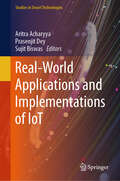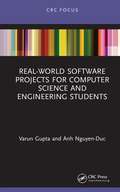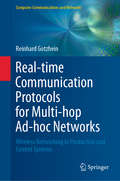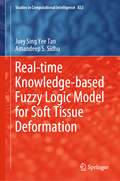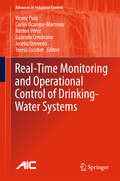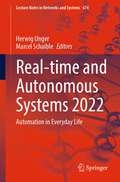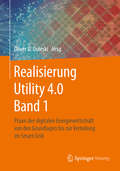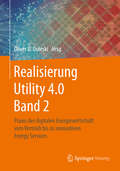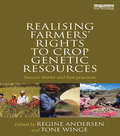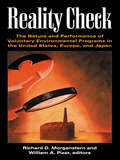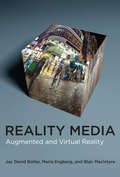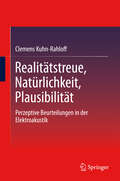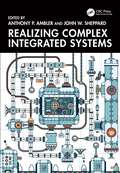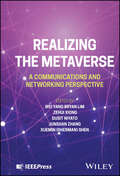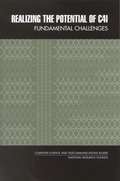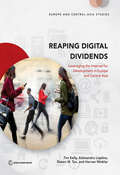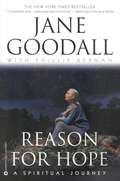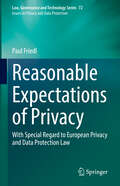- Table View
- List View
Real-World Applications and Implementations of IoT (Studies in Smart Technologies)
by Aritra Acharyya Prasenjit Dey Sujit BiswasThis book explores state-of-the-art internet of things (IoT) solutions for energy conservation, security, agricultural advancements, mining security, healthcare, and environmental protection. This book delves deep into the technology, offering a comprehensive analysis, detailed descriptions, and in-depth discussions of recently developed IoT applications. With a strong focus on the cutting-edge research at a global scale, the book combines IoT with artificial intelligence (AI), shedding light on emerging possibilities and advancements. Designed to cater to a broad audience, from those with a foundational understanding of science to seasoned engineering and technology experts, this book can serve as an essential resource for engineering students and science master's programs. Researchers seeking to stay at the forefront of IoT and AI will also find it invaluable.
Real-World Software Projects for Computer Science and Engineering Students
by Varun Gupta Anh Nguyen-DucDeveloping projects outside of a classroom setting can be intimidating for students and is not always a seamless process. Real-World Software Projects for Computer Science and Engineering Students is a quick, easy source for tackling such issues. Filling a critical gap in the research literature, the book: Is ideal for academic project supervisors. Helps researchers conduct interdisciplinary research. Guides computer science students on undertaking and implementing research-based projects This book explains how to develop highly complex, industry-specific projects touching on real-world complexities of software developments. It shows how to develop projects for students who have not yet had the chance to gain real-world experience, providing opportunity to become familiar with the skills needed to implement projects using standard development methodologies. The book is also a great source for teachers of undergraduate students in software engineering and computer science as it can help students prepare for the risk and uncertainty that is typical of software development in industrial settings.
Real-World Wireless Sensor Networks
by Luca Mottola Koen Langendoen Wen Hu Federico Ferrari Marco ZimmerlingThis edited book presents the results of the 5th Workshop on Real-world Wireless Sensor Networks (REALWSN). The purpose of this workshop was to bring together researchers and practitioners working in the area of sensor networks, with focus on real-world experiments or deployments of wireless sensor networks. Included were, nonetheless, emerging forms of sensing such as those that leverage smart phones, Internet of Things, RFIDs, and robots. Indeed, when working with real-world experiments or deployments, many new or unforeseen issues may arise: the network environment may be composed of a variety of different technologies, leading to very heterogeneous network structures; software development for large scale networks poses new types of problems; the performance of prototype networks may differ significantly from the deployed system; whereas actual sensor network deployments may need a complex combination of autonomous and manual configuration. Furthermore, results obtained through simulation are typically not directly applicable to operational networks; it is therefore imperative for the community to produce results from experimental research. The workshop collected the state of the art in emerging and current research trends dealing with Real-world Wireless Sensor Networks, with the aim of representing a stepping stone for future research in this field.
Real-time Communication Protocols for Multi-hop Ad-hoc Networks: Wireless Networking in Production and Control Systems (Computer Communications and Networks)
by Reinhard GotzheinThis book focuses on core functionalities for wireless real-time multi-hop networking with TDMA (time-division multiple access) and their integration into a flexible, versatile, fully operational, self-contained communication system. The use of wireless real-time communication technologies for the flexible networking of sensors, actuators, and controllers is a crucial building block for future production and control systems. WirelessHART and ISA 100.11a, two technologies that have been developed predominantly for industrial use, are currently available. However, a closer analysis of these approaches reveals certain deficits. Current research on wireless real-time communication systems shows potential to remove these limitations, resulting in flexible, versatile, and robust solutions that can be implemented on today’s low-cost and resource-constrained hardware platforms. Unlike other books on wireless communication, this book presents protocols located on MAC layer and above, and build on the physical (PHY) layer of standard wireless communication technologies.
Real-time Knowledge-based Fuzzy Logic Model for Soft Tissue Deformation (Studies in Computational Intelligence #832)
by Amandeep S. Sidhu Joey Sing TanThis book provides a real-time and knowledge-based fuzzy logic model for soft tissue deformation. The demand for surgical simulation continues to grow, as there is a major bottleneck in surgical simulation designation and every patient is unique. Deformable models, the core of surgical simulation, play a crucial role in surgical simulation designation. Accordingly, this book (1) presents an improved mass spring model to simulate soft tissue deformation for surgery simulation; (2) ensures the accuracy of simulation by redesigning the underlying Mass Spring Model (MSM) for liver deformation, using three different fuzzy knowledge-based approaches to determine the parameters of the MSM; (3) demonstrates how data in Central Processing Unit (CPU) memory can be structured to allow coalescing according to a set of Graphical Processing Unit (GPU)-dependent alignment rules; and (4) implements heterogeneous parallel programming for the distribution of grid threats for Computer Unified Device Architecture (CUDA)-based GPU computing.
Real-time Monitoring and Operational Control of Drinking-Water Systems
by Vicenç Puig Carlos Ocampo-Martínez Ramon Pérez Gabriela Cembrano Joseba Quevedo Teresa EscobetThis book presents a set of approaches for the real-time monitoring and control of drinking-water networks based on advanced information and communication technologies. It shows the reader how to achieve significant improvements in efficiency in terms of water use, energy consumption, water loss minimization, and water quality guarantees. The methods and approaches presented are illustrated and have been applied using real-life pilot demonstrations based on the drinking-water network in Barcelona, Spain. The proposed approaches and tools cover: * decision-making support for real-time optimal control of water transport networks, explaining how stochastic model predictive control algorithms that take explicit account of uncertainties associated with energy prices and real demand allow the main flow and pressure actuators--pumping stations and pressure regulation valves-- and intermediate storage tanks to be operated to meet demand using the most sustainable types of source and with minimum electricity costs; * decision-making support for monitoring water balance and distribution network quality in real time, implementing fault detection and diagnosis techniques and using information from hundreds of flow, pressure, and water-quality sensors together with hydraulic and quality-parameter-evolution models to detect and locate leaks in the network, possible breaches in water quality, and failures in sensors and/or actuators; * consumer-demand prediction, based on smart metering techniques, producing detailed analyses and forecasts of consumption patterns, providing a customer communications service, and suggesting economic measures intended to promote more efficient use of water at the household level. Researchers and engineers working with drinking-water networks will find this a vital support in overcoming the problems associated with increased population, environmental sensitivities and regulation, aging infrastructures, energy requirements, and limited water sources.
Real-time and Autonomous Systems 2022: Automation in Everyday Life (Lecture Notes in Networks and Systems #674)
by Herwig Unger Marcel SchaibleThis book contains the results of the researchers presented at this conference, which is supported by German Society of informatics (GI) and other organisations Real-Time Systems Expert Committees. The 43rd Real-Time Systems conference on "Automation in Everyday Life" is addressing an increasingly important topic in a world that is becoming more and more networked. The solutions presented here range from hardware to system design to individual applications. The target audience is students and researchers in computer science and automation technology (partly electrical engineering), engineers, programmers and users of automation and communication systems.
Realisierung Utility 4.0 Band 1: Praxis der digitalen Energiewirtschaft von den Grundlagen bis zur Verteilung im Smart Grid
by Oliver D. DoleskiBei der Digitalisierung des Energiesektors von Praxiserfahrungen anderer Experten profitieren! Dieser bewährten Devise folgend zeigen Autoren aus Versorgungs- und IT-Unternehmen, Beratungen und Start-ups ausgewählte Lösungen für eine erfolgreiche digitale Transformation der Energiebranche. Durch die Lektüre der ersten zweibändigen Fachpublikation zur Digitalisierung der Energiewirtschaft im deutschsprachigen Raum kann der Leser von Expertenwissen profitieren und seinen Nutzen aus realen Anwendungsfällen sowie der Beschreibung umgesetzter Geschäftsmodelle der digitalen Energiewelt ziehen.In Band 1 werden die wesentlichen Grundlagen des digitalen Business in der Energiewirtschaft präsentiert. Dem Einführungsteil folgen vier Abschnitte zu unterschiedlichen Facetten der Digitalisierung entlang der energiewirtschaftlichen Wertschöpfung von der Erzeugung bis zur Verteilung im Smart Grid.
Realisierung Utility 4.0 Band 2: Praxis der digitalen Energiewirtschaft vom Vertrieb bis zu innovativen Energy Services
by Oliver D. DoleskiBei der Digitalisierung des Energiesektors von Praxiserfahrungen anderer Experten profitieren! Dieser bewährten Devise folgend zeigen Autoren aus Versorgungs- und IT-Unternehmen, Beratungen und Start-ups ausgewählte Lösungen für eine erfolgreiche digitale Transformation der Energiebranche. Durch die Lektüre der ersten zweibändigen Fachpublikation zur Digitalisierung der Energiewirtschaft im deutschsprachigen Raum kann der Leser von Expertenwissen profitieren und seinen Nutzen aus realen Anwendungsfällen sowie der Beschreibung umgesetzter Geschäftsmodelle der digitalen Energiewelt ziehen. Band 2 führt die Gliederung entlang der energiewirtschaftlichen Wertschöpfung des ersten Bands fort. Das Spektrum reicht von den vertrieblichen Aspekten der digitalen Energiewelt bis hin zu Praxisbeiträgen zum Zusammenwachsen von Energie, Mobilität, Kommunikation und Stadtentwicklung.
Realising Farmers' Rights to Crop Genetic Resources: Success Stories and Best Practices
by Regine Andersen Tone WingeFarmers' Rights are essential for maintaining crop genetic diversity, which is the basis of all food and agricultural production in the world. The International Treaty on Plant Genetic Resources for Food and Agriculture recognizes Farmers' Rights and provides for relevant measures. However, implementation is slow, and in many countries there is resistance. This book shows the necessity of realizing Farmers' Rights for poverty alleviation and food security, the practical possibilities of doing so, and the potential gains for development and society at large. It provides decision-makers and practitioners with a conceptual framework for understanding Farmers’ Rights and success stories showing how each of the elements of Farmers' Rights can be realized in practice. The success stories have brought substantial achievements as regards one or more of the four elements of Farmers' Rights: the rights of farmers to save, use, exchange and sell farm-saved seed; the protection of traditional knowledge; benefit- sharing; and participation in decision-making. This does not mean that these examples are perfect. Challenges encountered on the way are conveyed and offer important lessons. The stories represent different regions and localities, including Europe, Asia, Africa and Latin America, as well as various categories of stakeholders and types of initiatives and policies.
Reality Check: The Nature and Performance of Voluntary Environmental Programs in the United States, Europe, and Japan
by Richard D. Morgenstern William A. PizerSince the early 1990s, voluntary programs have played an increasingly prominent role in environmental management in the U.S. and other industrialized countries. Programs have attempted to address problems ranging from climate change and energy efficiency, to more localized air and water pollution problems. But do they work? Despite a growing theoretical literature, there is limited empirical evidence on their success or the situations most conducive to the approaches. Even less is known about their cost-effectiveness. Getting credible answers is important. Research to date has been largely limited to individual programs. This innovative book seeks to clarify what is known by looking at a range of program types, including different approaches adopted in different nations. The focus is on assessing actual performance via seven case studies, including the U.S. Climate Wise program, the U.S. EPA's 33/50 program on toxic chemicals, the U.K. Climate Change Agreements, and the Keidanren Voluntary Action Plan in Japan. The central goals of Reality Check are understanding outcomes and, more specifically, the relationship between outcomes and design. By including in-depth analyses by experts from the U.S., Europe, and Japan, the book advances scholarship and provides practical information for the future design of voluntary programs to stakeholders and policymakers on all sides of the Atlantic and Pacific.
Reality Media: Augmented and Virtual Reality
by Jay David Bolter Maria Engberg Blair MacIntyreHow augmented reality and virtual reality are taking their places in contemporary media culture alongside film and television.TThis book positions augmented reality (AR) and virtual reality (VR) firmly in contemporary media culture. The authors view AR and VR not as the latest hyped technologies but as media—the latest in a series of what they term &“reality media,&” taking their places alongside film and television. Reality media inserts a layer of media between us and our perception of the world; AR and VR do not replace reality but refashion a reality for us. Each reality medium mediates and remediates; each offers a new representation that we implicitly compare to our experience of the world in itself but also through other media. The authors show that as forms of reality media emerge, they not only chart a future path for media culture, but also redefine media past. With AR and VR in mind, then, we can recognize their precursors in eighteenth-century panoramas and the Broadway lights of the 1930s. A digital version of Reality Media, available through the book&’s website, invites readers to visit a series of virtual rooms featuring interactivity, 3-D models, videos, images, and texts that explore the themes of the book.
Reality Television and Arab Politics: Contention in Public Life
by Marwan M. KraidyWhat does it mean to be modern outside the West? Based on a wealth of primary data collected over five years, Reality Television and Arab Politics analyzes how reality television stirred an explosive mix of religion, politics, and sexuality, fuelling heated polemics over cultural authenticity, gender relations, and political participation in the Arab world. The controversies, Kraidy argues, are best understood as a social laboratory in which actors experiment with various forms of modernity, continuing a long-standing Arab preoccupation with specifying terms of engagement with Western modernity. Women and youth take center stage in this process. Against the backdrop of dramatic upheaval in the Middle East, this book challenges the notion of a monolithic "Arab Street" and offers an original perspective on Arab media, shifting attention away from a narrow focus on al-Jazeera, toward a vibrant media sphere that compels broad popular engagement and contentious political performance.
Realitätstreue, Natürlichkeit, Plausibilität
by Clemens Kuhn-RahloffDieses Buch richtet sich an Ingenieure und Forscher im Bereich der Kommunikationsakustik und anderen Gebieten der Wahrnehmungsforschung. Es bewegt sich im interdisziplinären Feld von Kommunikationsakustik, Informationstheorie und Wahrnehmungspsychologie und liefert einen wesentlichen Beitrag zum Verständnis der akustischen Wahrnehmung. Im Zentrum steht dabei der Begriff der Plausibilität als grundlegender Bestandteil kommunikationsakustischer Technik. Um Eigenschaften von Plausibilitätsurteilen bei der akustischen Wahrnehmung zu von Menschen zu erörtern, stellt das Buch ausgewählte top-down-Prozesse der Wahrnehmung in den Vordergrund, die das Urteilsverhalten beeinflussen. Plausibilität wird im Kontext existierender Modelle für perzeptive Messungen dargestellt und die Anforderungen werden diskutiert, die an den Begriff gestellt werden, wenn er im psychoakustischen Sinn als Messgröße aufgefasst wird.
Realizing Africa's Rice Promise
by David Johnson Marco Wopereis Nourollah Ahmadi Abdulai Jalloh Eric Tollens*Includes contributions from the key scientists working in the area *Provides a comprehensive overview of the latest research as well as making recommendations for how best to deal with future challenges *Has a wide and varied scope - covering policy, genetic diversity and improvement, sustainable productivity enhancement, innovations and value chains
Realizing Africa's Rice Promise
by David E. Johnson Nourollah Ahmadi Abdulai Jalloh Eric Tollens Marco C.S. Wopereis*Includes contributions from the key scientists working in the area *Provides a comprehensive overview of the latest research as well as making recommendations for how best to deal with future challenges *Has a wide and varied scope – covering policy, genetic diversity and improvement, sustainable productivity enhancement, innovations and value chains
Realizing Complex Integrated Systems
by John W. Sheppard Anthony P. AmblerThe creation of complex integrated systems is, in itself, complex. It requires immense planning and a large team of people with diverse backgrounds based in dispersed geographical locations (and countries) supposedly working to a coordinated schedule and cost. The systems engineering task is not new, but recent scales most definitely are. The world is now capable of designing and manufacturing systems whose complexity was not considered possible 10 years ago. While many are trained to think in terms of a complete system, where ‘everything’ is designed and produced by a single project team, today such systems involve integrating subsystems and components (which are also complex) that have been developed by other project teams. Inevitably, this introduces additional complexities, involving elements out of the direct control of the project, but which are essential to its overall success.In addition to traditional systems engineering topics of hardware and software design, testability, and manufacturability, there are wider issues to be contemplated: project planning; communication language (an issue for international teams); units of measure (imperial vs. metric) used across members of the team; supply chains (pandemics, military action, and natural disasters); legal issues based on place of production and sale; the ethics associated with target use; and the threat of cyberattack. This book is the first attempt to bring many of these issues together to highlight the complexities that need to be considered in modern system design. It is neither exhaustive nor comprehensive, but it gives pointers to the topics for the reader to follow up on in more detail.
Realizing Strategy through Projects: The Executive's Guide (Best Practices in Portfolio, Program, and Project Management)
by Carl MarnewickExecutives should not necessarily know the intricacies of project management, but they should know how project management, as a discipline, can benefit the organization in implementing its strategies and realizing its vision. The only way that executives can effectively apply project management to realize these goals is to have sound knowledge of the project management discipline. The purpose of this book is to provide executives with a comprehensive overview of the discipline of project management. It focuses on the benefits of project management to an organization. The goal is to provide executives with a view as to how project management can deliver organizational strategies. The various chapters focus on specific aspects within the project management discipline and how each aspect should be managed from a business perspective. The book covers the entire spectrum of project management from a management and leadership perspective. The focus is not necessarily on what needs to be done from a project management perspective, but on what organizations and senior executives can do to facilitate projects. The book covers: The value of project management Project management as a strategic enabler Project, program, and portfolio management The role of the project management office in the successful delivery of projects, programs, and portfolios The benefits of project deliverables bring Sustainability of the organization Governance and the role of the project sponsor. The book concludes with a comprehensive portfolio, program, and project management framework. This holistic framework enables organizations to achieve value from project management and realize strategic goals.
Realizing an Andreev Spin Qubit: Exploring Sub-gap Structure in Josephson Nanowires Using Circuit QED (Springer Theses)
by Max HaysThe thesis gives the first experimental demonstration of a new quantum bit (“qubit”) that fuses two promising physical implementations for the storage and manipulation of quantum information – the electromagnetic modes of superconducting circuits, and the spins of electrons trapped in semiconductor quantum dots – and has the potential to inherit beneficial aspects of both. This new qubit consists of the spin of an individual superconducting quasiparticle trapped in a Josephson junction made from a semiconductor nanowire. Due to spin-orbit coupling in the nanowire, the supercurrent flowing through the nanowire depends on the quasiparticle spin state. This thesis shows how to harness this spin-dependent supercurrent to achieve both spin detection and coherent spin manipulation. This thesis also represents a significant advancement to our understanding and control of Andreev levels and thus of superconductivity. Andreev levels, microscopic fermionic modes that exist in all Josephson junctions, are the microscopic origin of the famous Josephson effect, and are also the parent states of Majorana modes in the nanowire junctions investigated in this thesis. The results in this thesis are therefore crucial for the development of Majorana-based topological information processing.
Realizing the Metaverse: A Communications and Networking Perspective
by Dusit Niyato Junshan Zhang Xuemin Sherman Shen Zehui Xiong Wei Yang Bryan LimA guide to the challenges in making virtual reality, reality The Metaverse, a version of the internet in which online interactions take place in real time within fully realized virtual spaces, has been promised as the next frontier in wireless communication. It has drawn huge investment from Silicon Valley and widespread media attention. However, the technologies required to make the Metaverse a reality are still in their infancy, and significant barriers must be overcome if this massive step is to be taken. Realizing the Metaverse provides a systematic overview of these challenges and their likely solutions. Focusing on five key areas—infrastructure, access, intelligence, security, and future developments—it offers one of the first comprehensive, formalized treatments of the Metaverse as a nascent reality. It promises to be an integral contribution to the future development of Metaverse technologies. Realizing the Metaverse readers will also find: An editorial team with extensive research experience in the field Detailed discussion of topics such as augmented reality (AR) adaptation, haptic feedback, artificial intelligence, and more Enlightening discussion of open questions and future prospects for research Realizing the Metaverse is ideal for graduate and advanced undergraduate students in wireless technology, network communications, and related fields, as well as for researchers and industry professionals involved with the Metaverse or adjacent technologies.
Realizing the Potential of C4I: Fundamental Challenges
by Committee to Review DOD C4I Plans ProgramsRapid progress in information and communications technologies is dramatically enhancing the strategic role of information, positioning effective exploitation of these technology advances as a critical success factor in military affairs. These technology advances are drivers and enablers for the "nervous system" of the military—its command, control, communications, computers, and intelligence (C4I) systems—to more effectively use the "muscle" side of the military.Authored by a committee of experts drawn equally from the military and commercial sectors, Realizing the Potential of C4I identifies three major areas as fundamental challenges to the full Department of Defense (DOD) exploitation of C4I technology—information systems security, interoperability, and various aspects of DOD process and culture. The book details principles by which to assess DOD efforts in these areas over the long term and provides specific, more immediately actionable recommendations. Although DOD is the focus of this book, the principles and issues presented are also relevant to interoperability, architecture, and security challenges faced by government as a whole and by large, complex public and private enterprises across the economy.
Reaping Digital Dividends: Leveraging the Internet for Development in Europe and Central Asia
by Tim Kelly Winkler Aleksandra Liaplina Shawn W. TanFrom East to West, the economies of Europe and Central Asia (ECA) are not taking full advantage of the internet to foster economic growth and job creation. The residents of Central Asia and the South Caucasus pay some of the highest prices in the world for internet connections that are slow and unreliable. In contrast, Europe enjoys some of the world’s fastest and affordable internet services. However, its firms and individuals are not fully exploiting the internet to achieve higher productivity growth as well as more and better jobs. Reaping Digital Dividends investigates the barriers that are holding back the broader adoption of the internet in ECA. The report identifies the main bottlenecks and provides policy recommendations tailored to economies at varying levels of digital development. It concludes that policies to increase internet access are necessary but not sufficient. Policies to foster competition, international trade and skills supply, as well as adapting regulations to the changing business environment and labor markets, will also be necessary. In other words, Reaping Digital Dividends not only requires better connectivity, but also complementary factors that allow governments, firms and individuals to make the most out of it.
Rearming Israel: Defense Procurement Through The 1990s (Publications Of The Jaffee Center For Strategic Studies, Tel Aviv University #No. 17)
by Aharon Klieman Reuven PedatzurThis study analyzes the key functions of arms planning and procurement in the ongoing Israeli defence effort. Part I addresses individual constraints placed on the shaping of arms control policy. Part II asks how Israel might best meet its arms needs over the next decade.
Reason for Hope: A Spiritual Journey (Windsor Selection Ser.)
by Jane Goodall Phillip BermanAs a young woman, Jane Goodall was best known for her groundbreaking fieldwork with the chimpanzees of Gombe, Africa. Goodall's work has always been controversial, mostly because she broke the mold of research scientist by developing meaningful relationships with her "specimens" and honoring their lives as she would other humans. Now at the age of 60, she continues to break the mold of scientist by revealing how her research and worldwide conservation institutes spring from her childhood callings and adult spiritual convictions. Reason for Hope is a smoothly written memoir that does not shy away from facing the realities of environmental destruction, animal abuse, and genocide. But Goodall shares her antidote to the poison of despair with specific examples of why she has not lost faith. For instance, she shares her spiritual epiphany during a visit to Auschwitz; her bravery in the face of chimpanzee imprisonment in medical laboratories; and devotes a whole chapter to individuals, corporations, and countries that are doing the right thing. But most of all Goodall provides a beautifully written plea for why everyone can and must find a reason for hope. --Gail Hudson
Reasonable Expectations of Privacy: With Special Regard to European Privacy and Data Protection Law (Law, Governance and Technology Series #72)
by Paul Friedl‘Reasonable expectations of privacy’ have become a cornerstone concept in privacy and data protection legislation worldwide, extending today from US constitutional law to the GDPR, Article 8 ECHR, and various Asian and African data protection frameworks. This book offers a comprehensive analysis of this complex and ambiguous legal concept, addressing the many questions regarding its proper function, interpretation and application. Tracing the notion's evolution from the 1967 Supreme Court ruling in ‘Katz v United States’ to its status as a widespread paradigm of global privacy discourse, the work illuminates the many fallacies that pervade both academic and judicial interpretations. At its core, the book explores and evaluates four distinct models of ‘reasonable expectations,’ analysing their normative foundations and practical implications in depth. In doing so, the book also contributes to broader discussions within privacy and data protection theory, as it identifies and evaluates different strategies for regulating privacy conflicts, such as interest balancing or social norms-based regulation. Finally, the book also makes significant contributions to the scholarship on the EU General Data Protection Regulation (GDPR) and Article 8 ECHR, evaluating how 'reasonable expectations' operate within these contexts from empiric and normative perspectives.
